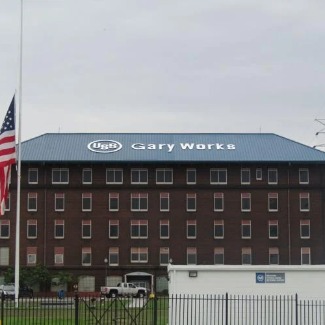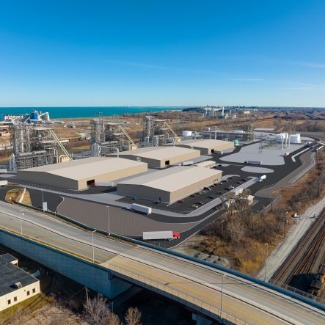This article is part of a ten-article series. See the full list of articles at the end of this one. The articles explore the issues Port of Harlem publisher Wayne Young uncovered and learned about while investing in his economically-challenged hometown, Gary, Indiana, and witnessing gentrification in once-economically challenged Washington, D.C.
The articles cover other places including South Bend, Indiana; Prince Georges County, Maryland; Washington, D.C.; Omaha, Nebraska; Flint, Michigan; Jackson, Mississippi; Florida, and the Lower Colorado River Basin States, specifically, California, Nevada, and Arizona.
Sargent, Edward, ed.
As Gary Methodist Hospital entered its second century in 2023, President and CEO Matt Doyle declared, "We will remain in the city of Gary for the next 100 years." The hospital is not the only pillar institution that is casting down its bucket where it is now. The city’s founder, the United State Steel Corporation, recently invested $60 million to produce 500,000 tons of pig iron annually and American Water is rolling out plans to replace lead water pipes and to spread the replacement cost equitably.
Along with Doyle’s commitment for Methodist Hospital to stay in Gary, there is a legal agreement that would make abandoning The Steel City a surgical nightmare. The agreement is the result of a suit filed in the 1970s by then-Mayor Richard Hatcher and others. (see Black Hospitals Die, How Does Gary’s Remain Alive.) A recent gift from United States Steel will support the hospital’s Vision Fund, which was established to ensure equitable health care for all those in need, now and in the future.
Massive losses of capital and population are experiences Gary; Flint, Michigan; and Jackson, Mississippi share along with having a majority economically-challenged Black population. One stark difference, however, between the cities is that Gary’s water system is privately owned . . .
United States Steel founded the city 117 years ago, in 1906, and built what would become the largest steel plant in the world. Japan-based Nippon Steel Corporation purchased U.S. Steel this month. U.S. Steel CEO David Burritt says Nippon plans to continue all of U.S. Steel's steelmaking and mining operations in the United States and keep operating all its assets. It will also keep the U.S. Steel brand name.
As the largest integrated mill in North America, the Gary Works plant will supply pig iron to the three billion-dollar Big River Steel mini-mill in Osceola, Arkansas. The Big River plant will in-turn supply Detroit-based General Motors with Verdex steel, a new sustainable steel product.
Integrated mills such as Gary Works make steel from scratch using blast furnaces to burn iron ore, limestone, and coke to make iron, which is turned into steel. The number of integrated mills along with their traditional blast furnaces have fallen dramatically in the United States as the number of mini-mills, such as the Big River mini-mill, continue to grow.
Verdex is helping to revolutionize the steel industry. It is manufactured with up to 75 percent fewer emissions compared to traditional blast furnace production, is made with up to 90-percent-recycled content, and is endlessly recyclable without degradation.
According to the Northwest Indiana Times, high-strength steel, such as that made with blast furnaces, protects drivers and passengers in accidents, resists corrosion, and meets other performance standards. This “is one of the reasons steelmakers haven't abandoned integrated steelmaking in places” like Gary in favor of lower-cost and less unionized mini-mill steels, reports The Times.
Even with newer mini-mills, Gary Works remains U. S. Steel's largest manufacturing plant with about 4,000 employees. The Pittsburgh based corporations also has plants across the United States and one in Slovakia.
Massive losses of capital and population are experiences Gary; Flint, Michigan; and Jackson, Mississippi share along with having a majority economically-challenged Black population. One stark difference, however, between the cities is that Gary’s water system is privately owned and its service area reaches beyond Gary to include a multi-racial, economically diverse region. Flint’s and Jackson’s water systems are city run and basically serve their respective cities.
Indiana America Water, owned by New Jersey-based American Water, is replacing lead pipes in Gary in a humane way.
According to Joe Loughmiller, External Affairs Manager for Indiana American Water, the company uses “two water treatment facilities to treat this water---one is located in Gary and a second treatment facility is located in Ogden Dunes along the lakeshore. Both of these system feed into the distribution system that serves the area.”
Indiana America Water, owned by New Jersey-based American Water, is replacing lead pipes in Gary in a humane way. Records show the company has up to 50,748 lead service lines running from distribution mains to customer meters, of which approximately 65 percent are in Northwest Indiana, primarily Gary.
If homeowners independently hired contractors to swap out their lead service line (LSL), they would have to pay between $4,000 and $5,500 each. However, the cost of the work will be borne by all customers. The replacements, which ultimately could total $177 million, will be recovered through standard rate adjustments, according to the Indiana Utility Regulatory Commission.
Loughmiller told Port of Harlem, “Our approach recognizes the societal cost of replacing LSLs, which tend to be in older, less affluent areas.” The company also expects the collective effort will lower the cost to approximately $3,500 to replace each customer-owned water line.








